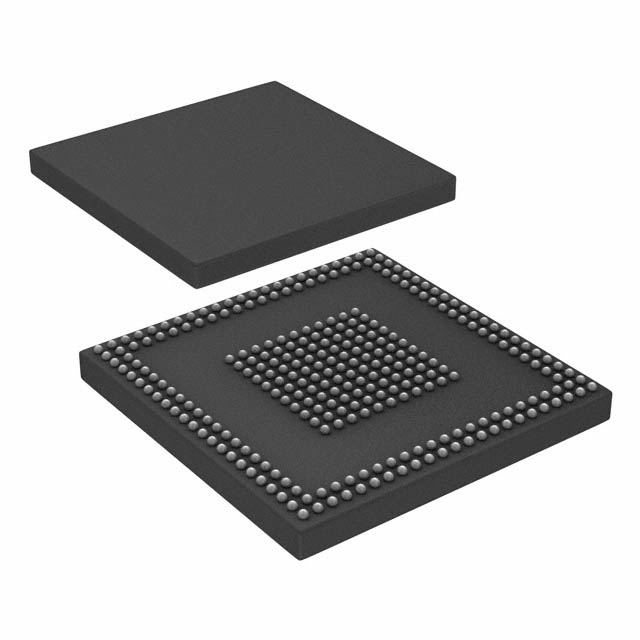ADSP-BF522KBCZ-4
Product Overview
Category
The ADSP-BF522KBCZ-4 belongs to the category of digital signal processors (DSPs).
Use
This DSP is designed for various applications that require high-performance signal processing capabilities, such as audio and video processing, telecommunications, industrial control systems, and medical imaging.
Characteristics
- High-performance signal processing capabilities
- Low power consumption
- Integrated peripherals for enhanced functionality
- Real-time processing capabilities
- Flexible programming options
Package
The ADSP-BF522KBCZ-4 comes in a compact package that allows for easy integration into different electronic systems. It is available in a surface-mount package.
Essence
The essence of the ADSP-BF522KBCZ-4 lies in its ability to efficiently process complex signals in real-time, enabling advanced functionalities in various applications.
Packaging/Quantity
The ADSP-BF522KBCZ-4 is typically packaged in reels or trays, depending on the quantity ordered. The exact packaging and quantity can vary based on the manufacturer's specifications.
Specifications
- Processor Core: Blackfin® 16-/32-bit embedded processor
- Clock Speed: Up to 400 MHz
- Instruction Set: VLIW (Very Long Instruction Word)
- Memory: 64 KB L1 instruction cache, 64 KB L1 data cache, external memory interface
- Peripherals: UART, SPI, I2C, GPIO, timers, DMA controller, etc.
- Operating Voltage: 1.2V - 3.3V
- Power Consumption: Varies based on clock speed and usage
Detailed Pin Configuration
The ADSP-BF522KBCZ-4 has a specific pin configuration that facilitates its integration into electronic systems. Please refer to the datasheet provided by the manufacturer for the detailed pin configuration.
Functional Features
- High-performance signal processing capabilities for real-time applications
- Integrated peripherals for enhanced functionality and connectivity
- Flexible programming options, supporting various development environments and languages
- Low power consumption, suitable for battery-powered devices
- Efficient memory management for optimized performance
Advantages and Disadvantages
Advantages
- High-performance signal processing capabilities
- Integrated peripherals for enhanced functionality
- Flexible programming options
- Low power consumption
Disadvantages
- May require specialized knowledge for efficient programming and utilization
- Limited availability of alternative models with similar specifications
Working Principles
The ADSP-BF522KBCZ-4 operates based on the Blackfin® architecture, which combines a 16-bit fixed-point DSP and a 32-bit RISC processor. This architecture allows for efficient signal processing and control tasks, making it suitable for real-time applications. The processor executes instructions in parallel, utilizing the VLIW instruction set to maximize performance.
Detailed Application Field Plans
The ADSP-BF522KBCZ-4 can be applied in various fields, including:
- Audio and Video Processing: Enables high-quality audio and video processing in multimedia systems, home theaters, and professional audio equipment.
- Telecommunications: Supports signal processing tasks in telecommunication systems, such as voice recognition, echo cancellation, and data compression.
- Industrial Control Systems: Facilitates real-time control and monitoring in industrial automation systems, robotics, and process control.
- Medical Imaging: Provides signal processing capabilities for medical imaging devices, such as ultrasound machines and MRI scanners.
Detailed and Complete Alternative Models
While the ADSP-BF522KBCZ-4 is a highly capable DSP, there are alternative models available with similar specifications. Some notable alternatives include:
- ADSP-BF523KBCZ-5: Offers higher clock speed and additional features for more demanding applications.
- ADSP-BF524KBCZ-4: Provides increased memory capacity and enhanced peripheral options.
- ADSP-BF525KBCZ-6: Offers higher performance and extended connectivity options.
Please refer to the manufacturer's documentation for a comprehensive list of alternative models.
Word count: 552 words
Lista 10 Vanliga frågor och svar relaterade till tillämpningen av ADSP-BF522KBCZ-4 i tekniska lösningar
Sure! Here are 10 common questions and answers related to the application of ADSP-BF522KBCZ-4 in technical solutions:
Q: What is the ADSP-BF522KBCZ-4? A: The ADSP-BF522KBCZ-4 is a digital signal processor (DSP) from Analog Devices that offers high-performance processing capabilities for various applications.
Q: What are the key features of the ADSP-BF522KBCZ-4? A: Some key features include a 16-bit fixed-point DSP core, on-chip memory, multiple communication interfaces, and support for various peripherals.
Q: What are the typical applications of the ADSP-BF522KBCZ-4? A: The ADSP-BF522KBCZ-4 is commonly used in applications such as audio processing, industrial control systems, motor control, medical devices, and communications equipment.
Q: How much on-chip memory does the ADSP-BF522KBCZ-4 have? A: The ADSP-BF522KBCZ-4 has 48KB of on-chip program memory (L1 instruction cache) and 32KB of on-chip data memory (L1 data cache).
Q: What communication interfaces are supported by the ADSP-BF522KBCZ-4? A: The ADSP-BF522KBCZ-4 supports interfaces such as SPI, UART, I2C, SPORT (Serial Port), and GPIO (General Purpose Input/Output).
Q: Can the ADSP-BF522KBCZ-4 be used for real-time signal processing? A: Yes, the ADSP-BF522KBCZ-4 is designed for real-time signal processing applications and offers high-performance capabilities for such tasks.
Q: What development tools are available for programming the ADSP-BF522KBCZ-4? A: Analog Devices provides a comprehensive software development toolchain called CrossCore® Embedded Studio, which includes an integrated development environment (IDE) and debugging tools.
Q: Is the ADSP-BF522KBCZ-4 suitable for low-power applications? A: Yes, the ADSP-BF522KBCZ-4 is designed to be power-efficient and offers various power-saving features, making it suitable for low-power applications.
Q: Can the ADSP-BF522KBCZ-4 be used in battery-powered devices? A: Yes, the power-efficient design of the ADSP-BF522KBCZ-4 makes it suitable for battery-powered devices where power consumption is a critical factor.
Q: Are there any evaluation boards or development kits available for the ADSP-BF522KBCZ-4? A: Yes, Analog Devices offers evaluation boards and development kits specifically designed for the ADSP-BF522KBCZ-4, providing a convenient platform for prototyping and development.
Please note that the answers provided here are general and may vary depending on specific requirements and application scenarios.


